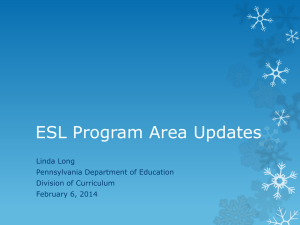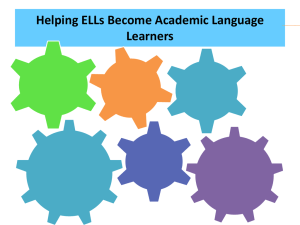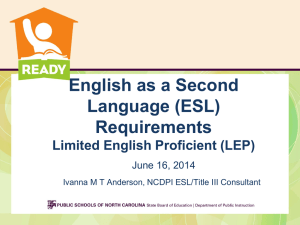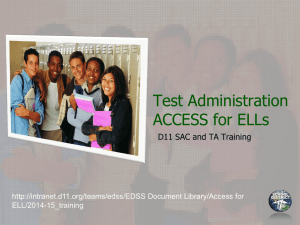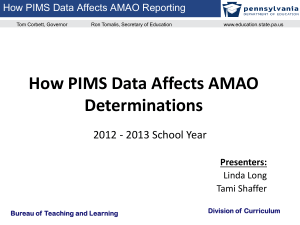PDE Program Updates Nov. 2013 File
advertisement
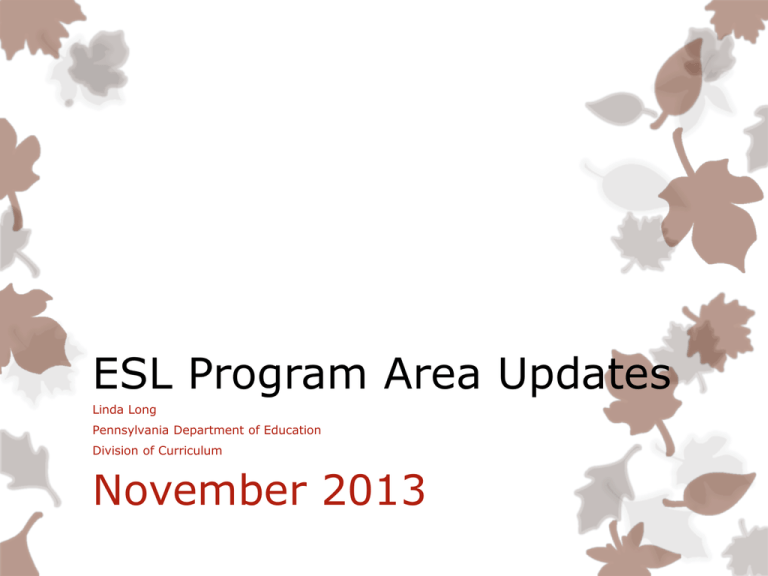
ESL Program Area Updates Linda Long Pennsylvania Department of Education Division of Curriculum November 2013 Mission for the Education of ELLs Provide for the maintenance and support of a thorough and efficient system of education which includes the provision of quality, culturally responsive, and equitable educational programs for English language learners and assurance of their appropriate participation in all aspects of the educational system. Ensure that its programs will address the needs and rights of English language learners in all its initiatives throughout the entire process of planning and implementation. Vision for the Education of ELLs Promotes the recognition of English language learners and their parents as cultural and linguistic assets to the Commonwealth’s global initiatives. Is committed to using its Standards Aligned System to ensure that English language learners receive core curriculum instruction and achieve high levels of academic success. Contents ESL Program Requirements Instructional Delivery Models Program Evaluation LEP Data November Precode New for 2013-14 ACCESS for ELLs Assessment Roles & Responsibilities Test Administrator Requirements for 2013-14 New for 2013-14 Title III & Accountability AMAO 3 Calculations for 2012-13 Data ESL Professional Development Technical Assistance ESL Toolkit dynamic, user-friendly, readily available, centralized, online repository of information and resources regarding mandated supports and programming for English language learners legal references model documents and forms recommended strategies and tools PDE guidance and communications timetables and contact information links to additional resources Accessible on the ESL Portal at http://www.eslportalpa.info August 2013: released November 2013: Resources added to Assessment tab under Summative Assessments ESL Program Requirements Identification, Placement, & Exit of ELLs Identified, placed, exited LEP status updated in SIS current ELL monitor 1 monitor 2 no longer monitored never an ELL Parent notifications sent LEP status reported to PIMS in October 1 District and School Enrollment Collection. Students reported as current English language learners in the PIMS October District and School Enrollment Collection cannot exit the English language instructional program from October until June. Planned Instruction Language Instruction Educational Program (LIEP) Every school district shall provide a program for each student whose dominant language is not English for the purpose of facilitating the student's achievement of English proficiency and the academic standards under § 4.12 (relating to academic standards). Programs under this section shall include appropriate bilingualbicultural or English as a second language (ESL ) instruction. 22 Pa. Code § 4.26 Basic Education Circular Each LEA must have a written program plan that includes: a detailed description of the instructional models implemented by the LEA, the process for identification of ELLs, the criteria for program exit, and the monitoring process after exit from a language instructional program. To access the BEC on the PDE website, click on the link: http://www.portal.state.pa.us/portal/server.pt/community/pa _codes/7501/educating_students_with_limited_english_profic iency_(lep)_and_english_language_learners_(ell)/507356 Instructional Models The Program model(s) that the LEA adopts for ELLs must be: 1) based on an educational theory recognized as sound by some experts in the field or considered by experts as a legitimate experimental strategy; 2) reasonably calculated, including provisions for resources and personnel, to implement the theory effectively; and 3) evaluated and adjusted where needed to ensure language barriers are actually being overcome. Castañeda v. Pickard, 648 F.2d 989 (1981) Program administrators planning the instructional models should consider LEA demographics, and student characteristics. Options for English language instructional programs are charted in the following: Characteristics of Major Program Models for LEP Students (PDF) NEW for 2013-14 Bilingual/ESL Program models are reported in PIMS in the programs fact template. Program codes are listed and described in PIMS Manual volume 2 appendix F. Collaboration between ESL Program Coordinators and PIMS Coordinators is essential. LIEP Defined The term "program" refers to: (1) planned instruction by a qualified ESL /Bilingual teacher, (2) adaptations/modifications in the delivery of content instruction by all teachers based on the student’s language proficiency level and the Pennsylvania Language Proficiency Standards (PA ELPS) for ELLs as well as the Pennsylvania academic standards. Educating Students With Limited English Proficiency (LEP) and English Language Learners (ELL) Program Evaluation Each LEA must periodically evaluate its language instructional program to ensure all components are aligned and working effectively to facilitate the acquisition of the English language and academic achievement defined by the PA academic standards. 22 Pa. Code § 4.52, Castañeda v. Pickard, 648 F.2d 989 (1981) and 20 U.S.C. § 6841 Data reported to LEAs from state level assessments of ELP and academic achievement (ACCESS for ELLs® and PSSA) must be used in program review and improvement. Challenges for ELLs and their Educators Improve the academic achievement of ELLs Promote high levels of content and language learning Hold all students to the same high standards Need to learn content while becoming proficient (double the work) Meet the academic standards Graduate and be equipped for college and career Opportunities for ELLs and their Educators Re-envision the education of ELLs Re-define language acquisition and proficiency to include academic literacy Re-examine your program Re-align curriculum, instruction, and assessments Effective ESL Programs: Meeting the Challenges and Embracing the Opportunities (August 21, 2013 webinar) Recording and power point available on the ESL Portal at the link below: http://www.eslportalpa.info/index.cfm?pageid=5255 Title III Monitoring USDOE will monitor PDE’s oversight of Title III Part A Scheduled for 4 days March-September 2014. 2-3 subgrantees/consortia will be monitored by USDOE as part of this process. For subgrantees/consortia it will involve: On site visit Submission of documentation 1 month prior to visit Selected LEAs will be notified and planning conference calls will be scheduled eMetric Data Interaction Tool November 15, 2013: eMetric has been updated to include the 2012-13 ACCESS for ELLs data E-metric is a dynamic online data tool that houses assessment results and LEA/student data for the WIDA Consortium’s English language proficiency assessment, ACCESS for ELLs. Please note: This tool is accessible only through a secure website (https://solutions.emetric.net/paaccess/) and users are reminded of the confidentiality of the system. Permission to access this data tool comes through the superintendent or program administrator. Superintendents/program administrators may contact snovakovic@state.pa.us for user ID and password information. LEAs, charter schools, and comprehensive CTCs can perform queries to obtain both individual and group summary assessment information. With e-Metric, users can perform the following activities: Create reports, graphs, or data files Disaggregate data Drill down from summaries to individual students Print or export reports Track students' performance from year to year Analyze performance on ACCESS for ELLs Useful information for providing appropriate instructional support and program evaluation! To access a recorded webinar and power point materials addressing the eMetric Data Interaction Tool, click on the following link: http://www.eslportalpa.info/index.cfm?pageid=5255 ACCESS for ELLs Growth Charts Measuring growth helps you see how far students have come compared to where they started. Planning opportunities for language learning and utilizing strengths in one domain to support other domains. Helps look at trends or patterns to make improvements Resources: Focus on Growth (attached) WIDA Percentile Growth Charts (attached) http://wida.us/assessment/ACCESS/index.aspx?growthreport=1 #scores Annual subscription available for ACCESS for ELLs Growth Reports to show district- and school-level growth trends. Your students’ English language proficiency (ELP) growth over two years is compared to the growth of students WIDA-wide. Contact Metritech at 800-747-4868 (WIDA Support) LEP Data Collection Data Related to LEP Students Accurate data is essential for federal reporting, accountability and data analysis purposes LEAs are responsible to report accurate data to PIMS and LEP System LEAs’ signature on Accuracy Certification Statement (ACS) attests that the data contained in PIMS or LEP System is true and accurate 2013-2014 Required LEP Data Collections Data Collected Window Templates Required Purpose Impact Student Data October Collects data on LEP students in programs designed for LEP students. This data is used for federal reporting purposes. Title III LEP & Immigrant Children & Youth funding determined by this report District Snapshot School Enrollment Programs Fact Student Student Snapshot School Enrollment Program Fact Student Student Snapshot Student Student Snapshot Program Fact District Fact Detailed calendar can be accessed on the PDE Website in Provides student precode labels for the ACCESS Labels for WIDA ACCESS for ELLs and Alternate November for ELLs, Alternate ACCESS for ELLs, PSSA ACCESS for ELLs assessments are generated from this Programs >> Programs O-R >> PIMS - Pennsylvania Information and Keystone test booklets. collection. Management System. PreCode ACCESS for ELLs Reporting Collection at: February LEP System March NA Application is online and accessed through the PDE Portal. ELL End of Year Count June Student Snapshot School Enrollment Program Fact Student District Fact Collects data on LEP and Title III LEP students who are administered the ACCESS for ELLs English Language Proficiency Assessment during the ACCESS for ELLs test window. This snapshot is used for federal reporting purposes and for accountability purposes. Collects counts of Title III nonpublic students served. This data is used to determine Title III allocations. Collects data on LEP students in programs designed for LEP students. This data is used for federal reporting purposes and program compliance monitoring. Collects data on LEP, ICY, and Title III students who were enrolled in a school at any time during the school year. This snapshot is used for federal reporting purposes. ACCESS Test Files are matched to reported LEP students. Test booklets that do not match demographic data in PIMS are invalidated for federal reporting and accountability purposes. Data MUST be accurate. Failure to report a count of nonpublic students served may negatively impact Title III funding. Based on compliance reviews, PDE provides technical assistance to LEAs. Reported to Congress. Impacts federal decisions concerning policy and funding for LEP and Immigrant students. New for 2013-14 PIMS October 1 Student Enrollment Snapshot Nonpublic student count in district fact template Title III Professional Development Survey 12-13 Title III PD activities in district fact template Precode Instructional delivery codes for ESL/Bilingual Education Program (Core) in programs fact template Instructional delivery codes for Title III Supplemental Program in programs fact template in PIMS June End of Year Collection Code for daily English language development instruction provided by the ESL teacher Program codes in PIMS Manual Vol. 2 appendix F ESL Coordinators and PIMS Coordinators must collaborate ACCESS for ELLs Assessment Communications to LEAs 2014 Administration of ACCESS for ELLs and Alternate ACCESS for ELLs 2014 ACCESS for ELLs Test Ordering Pennsylvania Criteria to Determine Participation in the Alternate ACCESS for ELLs Alternate ACCESS for ELLs Test Administrator Eligibility Requirements Documents are posted in ESL Toolkit under the Assessment tab, Summative Assessments: http://toolkit.eslportalpa.info/index.cfm?pageid=5338 Professional Development The following professional development webinars were delivered on November 5 and 7, 2013. Administering ACCESS for ELLs Kindergarten Administering ACCESS for ELLs Grades 1-12 Administering Alternate ACCESS for ELLs Test Ordering, Administrative, and Security Procedures Archived recordings, power point materials, and supporting documents are available on the ESL Portal (www.eslportalpa.info) within the ESL Toolkit under the Assessment tab, Summative Assessments. 2013-2014 Testing Schedule Task LEA Test Administrator Training Window LEAs Order Test Materials Start Date End Date -11/11/13 01/26/14 12/13/13 11/14/13 11/28/13 -01/27/14 -- 01/13/14 03/07/14 02/21/14 PIMS ACCESS for ELLS Data Collection Snapshot Date -- 03/07/14 PIMS ACCESS for ELLs Data Collection Period 03/07/14 03/14/14 LEAs Ship Completed Materials to MetriTech -- 03/14/14 PIMS Precode Data Collection period for ACCESS for ELLs® LEAs Receive Test Materials Test Window Order Additional Materials Deadline MetriTech Data Validation website open 04/22/14 for corrections PIMS ACCESS for ELLs Correction Window 04/22/14 PIMS ACCESS for ELLs data corrections (only for LEAs notified by PDE) 05/12/14 04/25/14 04/25/14 05/15/14 Reports Shipped to District* Week of 06/09/14* *Subject to change depending on timeliness of materials returned to Metritech and accuracy of demographic data in PIMS & Metritech. NEW for 2014: Test Administrator Certification Requirements All test administrators must certify or recertify on the group module, which addresses the significant changes to the administration and delivery of the listening component. Training requirements for 2014 test administration must be completed between October 7, 2013 and January 26, 2014. NEW for 2014: Alternate ACCESS for ELLs Alternate ACCESS for ELLs will be operational in PA for administration during the 2014 ACCESS for ELLs Testing Window (January 27—March 7, 2013) Alternate ACCESS is designed for ELL students who are significantly cognitively impaired Professional development webinar took place November 7, 2013. Recording and materials posted in ESL Toolkit under the Assessment tab, Summative Assessment: http://toolkit.eslportalpa.info/index.cfm?pageid=5338 Penn*Link is forthcoming ACCESS 2.0 2013-14 Field Test March 1-June 30, 2014 Administer 1 domain (reading) 2 hour administration per grade cluster Selected LEAs identified by CAL and WIDA to participate have been contacted Additional LEAs may volunteer to participate in the field test Training webinars: December 2013 -February 2014 Contact Pakou Vang at pakouvang@wisc.edu 2015-16 Fully Operational Title III & Accountability 2012-13 Accountability ESEA Flexibility Waiver targets In a State that received a waiver of the requirement to make AYP determinations, an LEA is still held accountable for AMAO 3. However, that accountability is now based on whether the subgroup of English Learners met its AMOs for reading/language arts and mathematics, the 95% participation rate requirement, and, if the LEA includes one or more high schools, the State’s graduation rate goal or annual target. (ESEA Flexibility Frequently Asked Questions Addendum, March 5, 2013) AMAO 1 and 2 N count is 11 (decreased from 40) AMAO 3 Indicators: Participation (95% for ELL subgroup) 4 year graduation rate cohort (85% or 10 % improvement) Percentage advanced/proficient of aggregate reading/Keystone literature for ELL subgroup (will include flep monitors 1 and 2, if their inclusion raises score) Percentage advanced/proficient of aggregate math/Algebra 1 for ELL subgroup (will include flep monitors 1 and 2, if their inclusion raises score) Targets: pending 2012-13 AMAO Status Reports pending 2012-2013 AMAO Improvement Planning Based on 10-11 AMAO Status Reports and 11-12 AMAO Status Reports 5 subgrantees in 2 year AMAO IP AMAO Improvement Plan Development: Notification of the Requirement to develop and implement an AMAO Improvement Plan based on preliminary 11-12 AMAO Status Reports—January 2013 Professional development—March 2013 Submission of AMAO Improvement Plan—May 2013 Submission of Assurance Statement--June 2013 Release of 11-12 AMAO Status Reports—July 2013 Implementation of plans & continued technical assistance Attend Data Retreat—April 2013 or January 2014 Complete Progress Check—February 2014 Ongoing implementation & evaluation—August 2014 2013-2014 Annual Measurable Achievement Objectives (AMAOs) AMAO 1 Annual Measurable Achievement Objective Target Annual increases in the number or percentage of children making progress towards learning English. 61% Definition: gain of > 0.6 ACCESS for ELLS composite proficiency level score AMAO 2 Annual increases in the number or percentage of children attaining English proficiency. 26% Definition: ACCESS for ELLs composite proficiency score of > 4.5 on a Tier B or C assessment or Kindergarten assessment AMAO 3 Adequate yearly progress (AYP) for LEP students. OR PA ESEA Flexibility Waiver indicators AYP Targets OR PA ESEA Flexibility Waiver targets Professional Development 2013-2014 ESL Professional Development Plan LEP Data—by PDE staff and WIDA PD Specialists Title III—by ESL TA Facilitators and PDE staff Improvement Planning—by ESL TA Facilitators, PDE staff, WIDA PD Specialists Assessment—by PDE staff and WIDA PD Specialists Instructional Practice —by PDE staff, ESL TA Facilitators, and WIDA PD Specialists Event descriptions and registration are available at www.eslportalpa.info Data Collection Webinars Target Audience: PIMS Administrators, PIMS Coordinators, District Test Facilitators Collection Date Topic Enrollment September 17, 18, PIMS Enrollment 24, Snapshot Training October 3 Precode November 4, 5 PIMS PSSA/ACCESS for ELLs Precode Training ACCESS February 19, 25 PIMS ACCESS for ELLs Snapshot Training LEP February 27 LEP System Data Collection Training End of Year June 10, 18 ESL End of Year Snapshot Training Title III Webinar Series Target Audience: Title III subgrantees and consortia Date Time Topic May 8, 2014 10 am-12 pm 1:30-3:30 pm Effective Instruction for Students with Limited or Interrupted Formal Education September 25, 2013 10 am-12 pm eMetric Data Interaction Tool for ACCESS for ELLs Basic User September 24 January 21 3-4pm TransACT: An overview of the Online Tool for Compliance and Parent Notification http://www.pdewebinars.org/viewwe binar.php?id=269 Advanced User November 19 March 25 http://www.pdewebinars.org/view webinar.php?id=268 The following recorded webinars and powerpoints are available on the ESL Portal at www.eslportalpa.info : Title III Application and Approved Activities Title III Requirements for Translation/Interpretation, Equitable Services for Nonpublic Students, Supplement v. Supplant Title III Requirements for Effective Applications, Use of Immigrant Children and Youth Funds, and Parental Engagement Title III Monitoring & Compliance Review Assessment Webinars • Target Audience: ACCESS Test Facilitators, ELL Coordinators, ACCESS Test Administrators Date Time Topic August 21, 2013 1:30-3:30 pm Use of the W-APT for Identification and Placement November 5, 2013 1:30-3:30 pm Administering Kindergarten ACCESS November 5, 2013 10 am-12 pm Administering ACCESS Grades 1-12 November 7, 2013 10 am-12 pm Administering Alternate ACCESS November 7, 2013 1:30-3:30 pm ACCESS Test Ordering & Security May 22, 2014 10 am-12 pm ACCESS for ELLs Score Interpretation Instruction of ELLs: Webinars Target Audience: ELL Coordinators, IU ESL Contacts, classroom, content, ESL, and special education teachers Date Time Topic August 21, 2013 10 am-12 pm Effective ESL Programs: Meeting the Challenges and Embracing the Opportunities January 22, 2014 March 12, 2014 April 10, 2014 10-11:30 am Implementing the PA ELL Overlays Series Instruction of ELLs: On site Trainings Target Audience: ELL Coordinators, IU ESL Contacts, classroom, content, ESL, and special education teachers Date & Site Topic September 4-5, 2013 (PaTTAN Pittsburgh) September 9-10, 2013 (PaTTAN Harrisburg) September 12-13, 2013 (PaTTAN King of Prussia) ELD Standards in Action: Collaboration October 7, 2013 (videoconference) (PaTTAN Pittsburgh) (PaTTAN Harrisburg) (PaTTAN King of Prussia) ESL Program Development and Compliance Training for Charter Schools October 25, 2013 (PaTTAN Pittsburgh) October 23, 2013 (PaTTAN Harrisburg) October 22, 2013 (PaTTAN King of Prussia) Data Discovery November 15, 2013 (videoconference) (PaTTAN Pittsburgh) (PaTTAN Harrisburg) (PaTTAN King of Prussia) PDE’s New ELL Overlays: Supporting Rigor Technical Assistance ESL Technical Assistance Protocol Level #1: ESL Toolkit Level #2: IU ESL Contact Level #3: ESL Technical Assistance Coordinator Level #4: PDE ESL Technical Assistance Coordinator After October 1, 2013 the provision of technical assistance with primary focus on priority schools and those Local Educational Agencies (LEAs) in Title III AMAO Improvement working with PDE staff to develop and implement ESL training opportunities and supportive resource materials support PDE staff by providing technical assistance, conducting site visits, coordinating professional development opportunities, gathering information and producing ESL tools and resources to assist in the provision of instruction to English Language Learners (ELLs). PDE Staff Division of Curriculum Linda Long | State Title III Director ESL/Bilingual Education Advisor lilong@pa.gov Tami Shaffer l Education Administration Associate tshaffer@pa.gov Division of Federal Programs Jesse Fry | Regional Coordinator jefry@pa.gov

